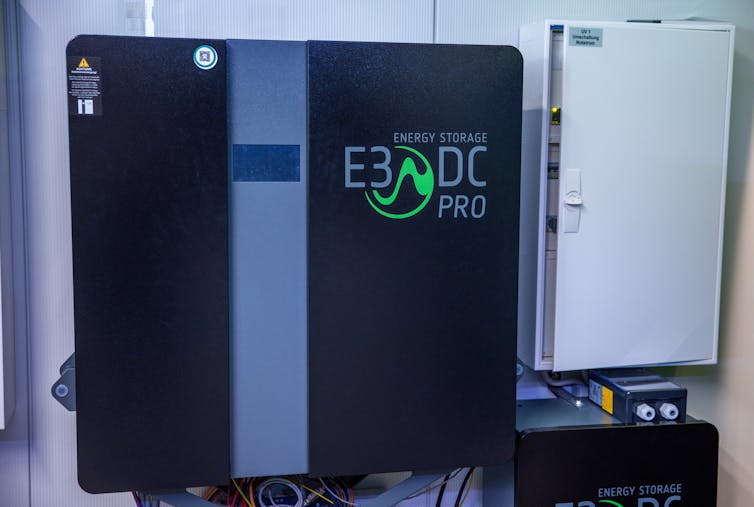
By Zoltan Nagy*
My colleagues and I have developed an artificial intelligence system that helps buildings shift their energy use to times when the electric grid is cleaner.
I’m an engineer who studies and develops smart buildings. My lab created Merlin, which learns how people use energy in their homes and adjust energy controls like thermostats to meet their needs while at the same time minimising the impact on the grid. The system can learn on one set of buildings and occupants and be used in buildings with different controls and energy use patterns.
We dubbed it Merlin after King Arthur’s legendary magician to reflect the magical nature of the system: it automatically collects data on how people use energy in their homes and identifies opportunities to charge and discharge home battery storage. And it does so in a way that you always have power for whatever you need. So your air conditioning is always available, but at the same time it reduces the strain on the grid – for example, during afternoon peaks.
If demand outstrips the available generation, utilities typically ask customers to adjust their thermostats and otherwise reduce their loads. If that’s not sufficient, blackouts are possible. This is where Merlin comes in. By managing energy use in homes more intelligently, Merlin helps balance the energy supply, making electric grids more stable and reliable. Merlin manages the grid’s use of the home’s battery while maintaining the home’s normal consumption of energy.
Why it matters
To address climate change, society needs to transition to generating electrical power exclusively using nonfossil fuel sources like solar, wind and nuclear. Also, all household appliances, or end uses – heating, cooking, clothes-drying – must be electrified. A similar transition is happening with cars, moving from internal combustion engine vehicles to battery electric vehicles. However, most renewable energy sources are non-dispatchable, meaning power companies can’t just turn them on when needed.
This requires a fundamental shift from a centralized energy system where a power plant generates all needed electricity, to a more decentralised or distributed one. In decentralised systems, power is generated at the edges of the grid – for example, in homes with solar panels – and homes and office buildings can store energy in batteries.
Homes and office buildings also actively try to reduce or shift their loads to reduce their demands on the grid. This means fewer blackouts and less wasted energy. Plus, using energy more efficiently helps reduce greenhouse gas emissions.
What other research is being done
Researchers are working on various ways to make buildings smarter and better at shifting their energy use. In fact, the US Energy Department has created a national road map to develop such grid-interactive efficient buildings to triple the energy efficiency and energy demand flexibility of buildings by 2030. In 2021, the department funded 10 projects of public-private partnerships with its Connected Communities program to develop and test technologies for grid-interactive buildings.
The International Energy Agency has supported a variety of programs in which researchers are working on software applications to enable smarter building operation, energy-flexible buildings and, more recently, grid-integrated control of buildings.
All these programs and developments focus on advanced control systems and promoting the adoption of smart technologies to optimise energy use, similar to Merlin.
What’s next
The next step is to test systems like Merlin in more communities under realistic conditions, and understand how well they work in different places and conditions. It is important that we gather feedback about users’ experiences and integrate them into our next prototypes to ensure the acceptability of AI systems managing people’s home energy. We are aiming to make these systems user-friendly and affordable so that everyone can benefit from smarter, greener homes.
The goal is for every neighborhood to have homes that share energy like a team, always making sure there’s enough power for everyone and using as little of it as possible from the grid.
The Research Brief is a short take on interesting academic work.![]()
*Zoltan Nagy, Assistant Professor of Civil, Architectural and Environmental Engineering, The University of Texas at Austin.
This article is republished from The Conversation under a Creative Commons license. Read the original article.
21 Comments
An excellent discussion on how we can extract more energy from our existing limited resources. We can expect to see more growth in future as we get more efficient and develop better technological solutions to environmental and economic problems.
Exciting times, and interested to see how we can better harness the resources at our fingertips.
it does so in a way that you always have power for whatever you need. So your air conditioning is always available, [...] but at the same time it reduces the strain on the grid
I don't get this guy. I can turn my heating on whenever i want, say early evening in winter when there is the greatest demand on the grid, and merlin means i can still consume this energy without it putting load on the grid? What is this magic?
identifies opportunities to charge and discharge home battery storage
Of right so it pulls from the battery instead of the grid. So what he's saying is home batteries can take load off the grid... amazing that nobody has figured this out before..., checks manual of cheap DEYE residential hybrid inverter... oh it seems you can already program it grid priority, battery priority etc
This requires a fundamental shift from a centralized energy system where a power plant generates all needed electricity, to a more decentralised or distributed one.
Well that's all very well and good for those that can afford to stick solar + battery in our homes. For the rest of us, a centralised system where a large grid battery can release charge exactly when the grid needs it seems far more workable and will cost far less than thousands of decentralised residential battery installs.
I'd be interested in why AI is needed rather than simply scheduling battery priority during peak periods? A simple communication protocol could make the scheduling more fine grained, so that homes can be told by the grid exactly when to favour battery over grid consumption, but this doesn't need AI.
Yes, its a complicated way to market something using the magic phrase "AI" that is essentially buying a household battery, charging it up on night rate power and then draining it during peak times. Same thing has been proposed at grid scale, and similar to whats also found in hybrid cars. The application of the word AI into something that could run on a raspberry pie is more about marketing, share price and attracting investors IMHO.
It doesn't even need a raspberry pie. household battery inverters already have this functionality built in.
An increasing number of people do have battery storage sitting on their driveways or in garages.
Micro-tuning aircon rather than relying the thermostat alone can save power, and minimize the load on the grid when the micro-tuners are all working together.
I could go on.
Each 'tunable system' in isolation may make a tiny saving. But make them completely aware of every other tunable system in a household or building and the savings mount up.
But the really big savings come when each household or building is aware of what every other household or building is doing.
Take a simple example of just two aircon systems. If they are unaware of each other, they could both be running at the same time. If they are aware of each other, the can alternate with the load on the grid, at that location, so the load is halved while the affected humans notice no change.
Scale this up and it looks like an intelligent system, so the term A.I. does fit.
I've developed such systems, i.e. made up of multiple disparate self tuning algorithms, and often found myself going, "Now why did it do that? Golly, that's smart! I had no idea it could do that!". But when I've drilled into the "why", I've found it makes perfect sense and was simply a decision path that I never considered. (Works both ways though, in that sometimes the outcome is less than desirable. We call these bugs.)
This is really an interesting notion. It's a bit like Google Maps, which has been using (and gathering) telemetry data from users for the past decade or more. Firing up Google Maps to scout the traffic ahead on the route, and if it's bad, follow the suggest detours, makes driving so much less annoying. Acting on shared information instead of each and everyone doing their own thing, particularly when the shared resources in question are scarce, makes sense from that point of view.
Thanks, your example provides far more insight than the article. smart scheduling of loads. But it's a real stretch to call that AI, it's just consumers competing for a lock on a resource. IT systems have done this for eternity.
I'm not sure though that your air-con example really helps at the grid level.
Sure in a single building, say with a residential single phase 63 amp supply, alternating two aircon could keep you under 63A in the face of other demand (water heading, induction cook top, spa pool heater etc).
But at a grid level there are thousands and thousands of aircons running, the constant on/off of the aircons will even out at the grid level without any intervention. What you actually need is to reduce demand for an hour during the peak, e.g. between 7:30am - 8:30am in the morning. The only way to eliminate the demand on that timescale while still allowing people to run their aircon, is batteries.
Fortunately the utilities have already figured this out and are installing grid-scale batteries at pace. I read yesterday that the installed base of grid scale batteries worldwide will soon be larger than pumped hydro.
We already have grid level 'turn things off at peak loads', albeit it is far from dynamic, nor is it consistently implemented.
I refer of course to the humble hot water cylinder. Which is also a battery of sorts. Domestic photovoltaic providers are already touting this 'battery' feature, i.e. heat your hot water (very hot!) while the sun shines rather than sell it back into the grid. Note that water can also be be used to store very cold water - below freezing - with the right chemicals added.
Your aircon example is a reference to just one consumption type, and that's the root of the problem. All types of consumption must be evaluated and understood for the entire system to be optimised.
That doesn't mean that 'grid scale' batteries aren't part of the solution. They will be. But grid scale batteries, in my book at least, include all types - pumped hydro, chemical, gravitation, mineral (heated salts), etc. etc.
We should be looking at grid scale battery solutions with long life spans (and low environmental impacts) even if the initial cost is high rather than quick fix solutions so that 'get rich quick' solution providers get rich because we're so hopeless at planning.
Do the solar panel generate more solar panels? Or how about more batteries?
Doesn't sound renewable. Or clean.
And power prices are going through the roof and we should now install a Second (!) set of infrastructure to sit alongside existing one.... and add in all the associated maintenance that comes with that!
So thats a fail on the economics as well.
Better to use coal and gas to make a solar panel than to make electricity.
Solar is looking like it will pay itself off sooner and sooner the more this energy turmoil continue. Used to be around 10-15years, but with higher costs of electricity, better PV panels and inflation eating the price away little by little each year also, the business case is improving.
interesting1234,
I am puzzled. I looked at a recent bill for friends with solar panels. They are with SolarCity, so pay them a fixed amount and a variable amount for the power they need on top of what their system gives them. For last March, their total payment was significantly higher than ours and our circumstances are similar. Two couples both retired in similar sized houses with double glazing and good insulation.
I guess it puts it all in one app. Asabove , inverter systems such as Victron's ESS already have these options.
Is the Victron's ESS aware of all the other Victron's ESS in the local neighborhood? Does is talk to the grid and ask how much spare capacity is available? Can it talk to EVs? HWCs? Heat pumps? Etc.
(I've been out of this space for years. My role was defining and evangelizing the use of open messaging formats so disparate 'systems' could talk to each other. Just wondering where the tech is at now. Your username suggests you'd know.)
Victron ESS isn't a smart grid, its for a single building, but from this article it sounds like that's the scope of 'Merlin', there's no mention of communicating with other buildings to manage grid demand.
The tricky bit is in the scheduling, if there is more demand than supply, how do you ration it? If it's an computer OS that is scheduling tasks on a CPU you simply give each task an equal slice, and allow the user to set priorities to influence that. In a single building your not robbing peter to pay paul, but at the neighbourhood level on a cold winters morning how do you prioritise demand? Is my heatpump more important than your oven?
Most electricity used by an oven is getting it up to temperature ... and would you notice if your heat pump kicked in a bit slower once the room was already near the set temperature ... or your jug took 30 seconds longer to boil ... see where I'm going?
No not at this stage. You can share your data, either with everyone(public ) , or selected users. The main idea of it is to allow you to select your essential loads, save enough battery / solar power to run them 24/7, then feed any excess to your non essential loads, and if setup, back to the grid. To some extent, it does figure out your usage pattern , and attempts to maximize production to suit. But it's main purpose is to ensure you have power for your essential loads. We used to call this kind of thing fuzzy logic, I'm more old school and almost all off grid systems.
My KISS solution would be to simply use voltage to control what is run , and what is fed back to the grid, if anything. If there is a lot of load on your local grid, the supply voltage will drop, and your system decides what to do on this basis. Modern electronics can detect small voltage difference cheaply, you could probably get bluetooth switch devices for $20-30 in China, $200 or so here. But a grid size system, yet probably has to be timebased, and using the spot pricing to reward / punish consumers. Danger is, people just ignore the cost and turn shit on anyway.
Easiest way is to control hot water, but the power companies had moved away from the ripple control to compete with gas.
Thanks for the reply, Sdb.
My takeaway would be, once one has a Victron's ESS, then an 'over the wire' software upgrade could add it to the 'energy hive'.
Which makes we wonder how long it will be before the building code requires such devices in all new homes ... ;-)
Wow. I wish I were younger to see this happen.
No worries.
Yes it is becoming more of a young mans game. The physical installation is pretty much plug and play , unless there are other components like hydro or wind. The real work is in setting it up so the customer gets the best value , using as much power as they can , and not exporting at a low rate. But most of the mainstream biggers just sell and walk away.There's probably a market for someone to concentrate on the load and control side, which is more software / app based.


We welcome your comments below. If you are not already registered, please register to comment.
Remember we welcome robust, respectful and insightful debate. We don't welcome abusive or defamatory comments and will de-register those repeatedly making such comments. Our current comment policy is here.